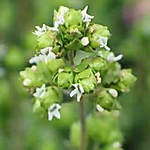| Common Name: |
Hardy Marjoram |
| Other Names: |
Italian Oregano |
| Botanical Name: |
Origanum x majoricum |
| Genus: |
Origanum |
| Family: |
Lamiaceae |
| Cultivation: |
Well-drained to dry, neutral to alkaline soil in sun. Origanum dictamnus needs sharp drainage and protection from wet winters. Orgianum majorana, O. x majoricum, and O. onites may be slightly hardier in a sheltered, sharply drained situation. |
| Propagation: |
By seed sown in autumn or at 10-13°C (50-55°F) in spring (species only); by basal cuttings in late spring; by division in spring. |
| Harvest: |
Plants are collected as flowering begins, and leaves during the growing season, and sued fresh, distilled for oil, or dried for infusions. |
| Height: |
45-60cm (18-24in) |
| Width: |
45cm (18in) |
| Hardiness: |
Z7 |
| Parts Used: |
Leaves |
| Properties: |
Similar to O. majorana |
| Culinary Uses: |
May be substituted for O. marjorana in cooking. |
| Bibliography: |
Encyclopedia of Herbs by Deni Brown. Copyright © 1995, 2001 Dorling Kindersley Limited. pp 295-296
|

